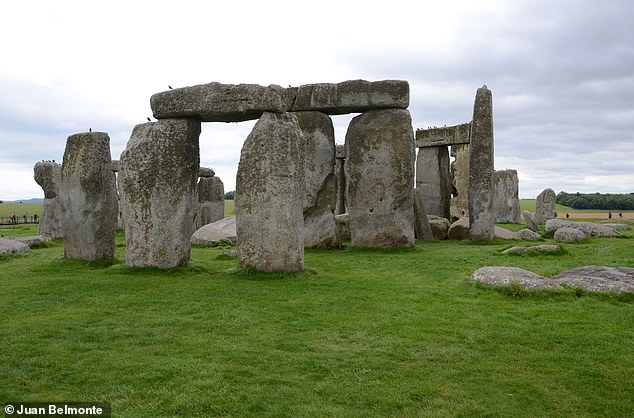
STONEHENGE: EXPERTS HIT BACK AT CLAIM THE STONES WERE CARRIED BY ICE
- Experts hit back at recent paper suggesting 'bluestones' were transported by ice
- READ MORE: Stonehenge was NOT a giant calendar, scientists argue
There's no doubt it's one of the world's most iconic historic sites and a British cultural icon.
But the debate over how Stonehenge came into existence about 5,000 years ago really is far from over.
A team of researchers has hit back at new study claiming that the landmark's 'bluestones' were transported from Wales naturally by glacier ice.
Leader Tim Daw, former historic property steward for Stonehenge and owner of the All Cannings Long Barrow, called the study 'nonsense' and 'seriously flawed'.
He told MailOnline that they were pulled by tribes along the ground using a series of logs – a generally-accepted theory for many decades.
In addition to the tall Sarsen stones that make up Stonehenge's distinctive appearance, the world-famous site is also home to around 80 smaller 'bluestones'.
It is generally agreed that these bluestones originate from Craig Rhos-y-Felin in the Preseli Hills of south-west Wales – but how exactly they got to Stonehenge is hotly debated.
Dr Brian John, a retired geology lecturer from Durham University, proposed in his new study that a 'lost' bluestone boulder taken from the Stonehenge site over 90 years ago shows that humans didn't move the stones at all.
Dr John said this bluestone boulder bears marks that suggest it was moved by glacial ice – challenging the common theory that it was manually transported from Wales to Salisbury Plain by tribes.
But Daw and his fellow researchers – including Richard Bevins, a geologist at Aberystwyth University – say it's known with 'absolute certainty' that humans moved all of Stonehenge's bluestones.
'They had the ability, knowledge and technology to transport them [the bluestones] – that isn't in question,' Daw told MailOnline.
'If you can move a rock a hundred meters, you can move it a hundred miles – that is simple logic.
'It might not be easy but it can be done.
'They were all moved into position and raised there by humans.'
What's more, Daw and his team contest Dr John's methods – which rely on his interpretations of the bluestone boulder.
Through a detailed analysis of the boulder's surface, Dr John identified a series of marks that suggest glacial impact and scarring, he said.
During a cold period of Earth's history before Stonehenge was built, much of Britain gradually froze over – in the process pushing bluestones from Wales southwards towards Wiltshire, he alleged.
However, Daw and colleagues contest this, firstly saying the ice didn't push as far south as that, and secondly that the marks on the boulder were made at Craig Rhos-y-Felin.
Daw said: 'When we look at the boulders that are still at Craig Rhos-y-Felin, which is where it came from, we can see that the erosion happened there.
'The stones there are already shaped and scarred, so none of the "evidence of glacial transport" can be shown to be from its journey from Wales to Wessex.'
Dr John called the theory that the bluestones were manually transported a 'myth' that's 'just been accepted as the truth'.
But Daw and others strongly refute this and think Dr John's study adds to public misconceptions about Stonehenge's history.
'This is just a very annoying background rumble of nonsense that gets picked up and spread which takes the time and effort of academics to repeatedly refute,' Daw told MailOnline.
'This time and effort that could be better spent on real scientific investigations into the marvels of Neolithic Britain.'
There is something both parties agree on, however – that it was only the bluestones that came from Wales.
The much larger and more famous Sarsens are from the chalk land of southern England, probably near Marlborough 15 miles from Stonehenge.
Read more 2024-06-29T09:15:30Z dg43tfdfdgfd